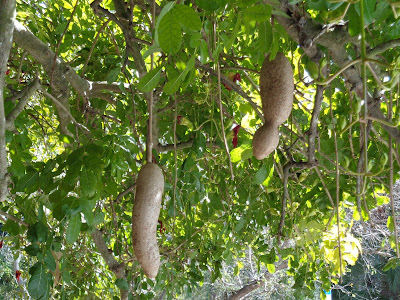Former houseplants from the north can often find their way
outside in our landscapes here in Southwest Florida. Once of those is the
Reflexed Dracaena which is considered an ornamental evergreen multi-stemmed
shrub sometimes obtaining small tree size. There are many cultivars of
Reflexed Dracaena available, but perhaps one of the most eye-catching type is
called ‘Song-of-India’. This variety is beautifully variegated and brings
a tropical flair to the landscape.
To start, the ‘Song-of-India’ is a bit cold sensitive and
will not appreciate temperatures below thirty-four degrees Fahrenheit. As
such, it is best to grow this plant in the warmer areas of Charlotte County or
in identified microclimates. Otherwise, be prepared to cover it for
protection or have it in a container that can be moved under indoors when
needed. It does make a great patio, lanai or indoor plant in a large
container. The ‘Song-of-India’ can grow unpruned to over eight feet
tall with irregular, multi-stemmed branches and somewhat slow growth.
Each leaf is four to six inches long with interesting variegation. Young
leaves start out green with distinct yellow margins. As the leaves age,
the darker green portion becomes lighter and the margins blend in with a
creamy color and more stripes. The leaves are arranged in an attractive
spiral pattern up the stem. As the leaves age out and drop, the stem is
bare and patterned with the remains of the leaf scares. At maturity, the
‘Song-of-India’ will actually produce a panicle of flowers consisting of small
green to yellow, almost inconspicuous blossoms. For a slightly different color
pattern, try ‘Song-of-Jamaica’, a cultivar with stripes of darker and lighter
green variegation.
If used in a formal tropical landscape, select a site in a
part-sun to bright filtered light location not exposed to salty
conditions – this plant is not salt-tolerant. As a container grown plant,
step it up into continuously larger pots as it grows using a sterile potting
medium with good drainage. Larger containers can even be put on platforms
with wheels for easy moving.
Propagation is very easy using
cuttings. Cuttings are a great way to share this plant with friends as a
pass-along plant. The ‘Song-of-India’ can be considered pest-free and a very
sustainable plant. When you see one, you will want one! For
more information on all types of plants suitable for both landscapes and
containers, please call our Master Gardener
volunteers on the Plant Lifeline on Mondays, Wednesdays and Fridays from 1 to 4
pm at 764-4340 for gardening help and insight into their role as an Extension
volunteer. Don't forget to visit our other County Plant Clinics in the
area. Please check this link for a complete list of site locations, dates
and times - http://charlotte.ifas.ufl.edu/horticulture/Plant%20Clinics%20Schedule.pdf.
Resources:
Brown, S. H. ( 2013) Dracaena reflexa ‘Song-of
India’. The University of Florida Extension Service, IFAS – Lee County.
Gilman, E. F. ( 2014) Dracaena reflexa Reflexed
Dracaena. The University of Florida Extension Service, IFAS – Lee County.










